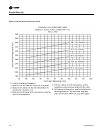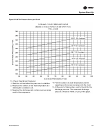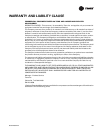
108 SS-SVX09A-EN
Service & Maintenance
ƽ WARNING
Hazardous Pressures!
Coils contain refrigerant under pressure. When cleaning coils, maintain coil cleaning solution
temperature under 150°F to avoid excessive pressure in the coil. Failure to follow these safety
precautions could result in coil bursting, which could result in death or serious injury.
Note: Refrigerant oil is detrimental to some roofing materials. Care must be taken to protect the
roof from oil leaks or spills.
5. Pour the cleaning solution into the sprayer. If a high-pressure sprayer is used:
a. do not allow sprayer pressure to exceed 600 psi.
b. the minimum nozzle spray angle is 15 degrees.
c. maintain a minimum clearance of 6" between the sprayer nozzle and the coil.
d. spray the solution perpendicular (at 90 degrees) to the coil face.
6. Spray the leaving-airflow side of the coil first; then spray the opposite side of the coil. Allow the
cleaning solution to stand on the coil for five minutes.
7. Rinse both sides of the coil with cool, clean water.
8. Inspect both sides of the coil; if it still appears to be dirty, repeat Steps 6 and 7.
9. Reinstall all of the components and panels removed in Step 1 and any protective covers
installed in step 2.
10. Restore the unit to it’s operational status and check system operation.
System operation
[ ] Close the main power disconnect switch for the condensing unit and all system support
equipment. Turn all system control circuit switches to the “On” position.
ƽ WARNING
Live Electrical Components!
During installation, testing, servicing and troubleshooting of this product, it may be necessary
to work with live electrical components. Have a qualified licensed electrician or other individual
who has been properly trained in handling live electrical components perform these tasks.
Failure to follow all electrical safety precautions when exposed to live electrical components
could result in death or serious injury.
[ ] With the unit running, check and record the:
ambient temperature;
compressor oil level (each circuit);
compressor suction and discharge pressures (each circuit);
superheat and Subcooling (each circuit);
Record this data on an “operator’s maintenance log” similar to the one illustrated in the “Final
Setup” section of this manual. If the operating pressures indicate a refrigerant shortage, measure
the system Superheat and system Subcooling. For guidelines, refer to the “System Start-Up”
section.
Note: Do Not release refrigerant to the atmosphere! If adding or removing refrigerant is required,
the service technician must comply with all federal, state and local laws. Refer to general
service bulletin MSCU-SB-1 (latest edition).


















